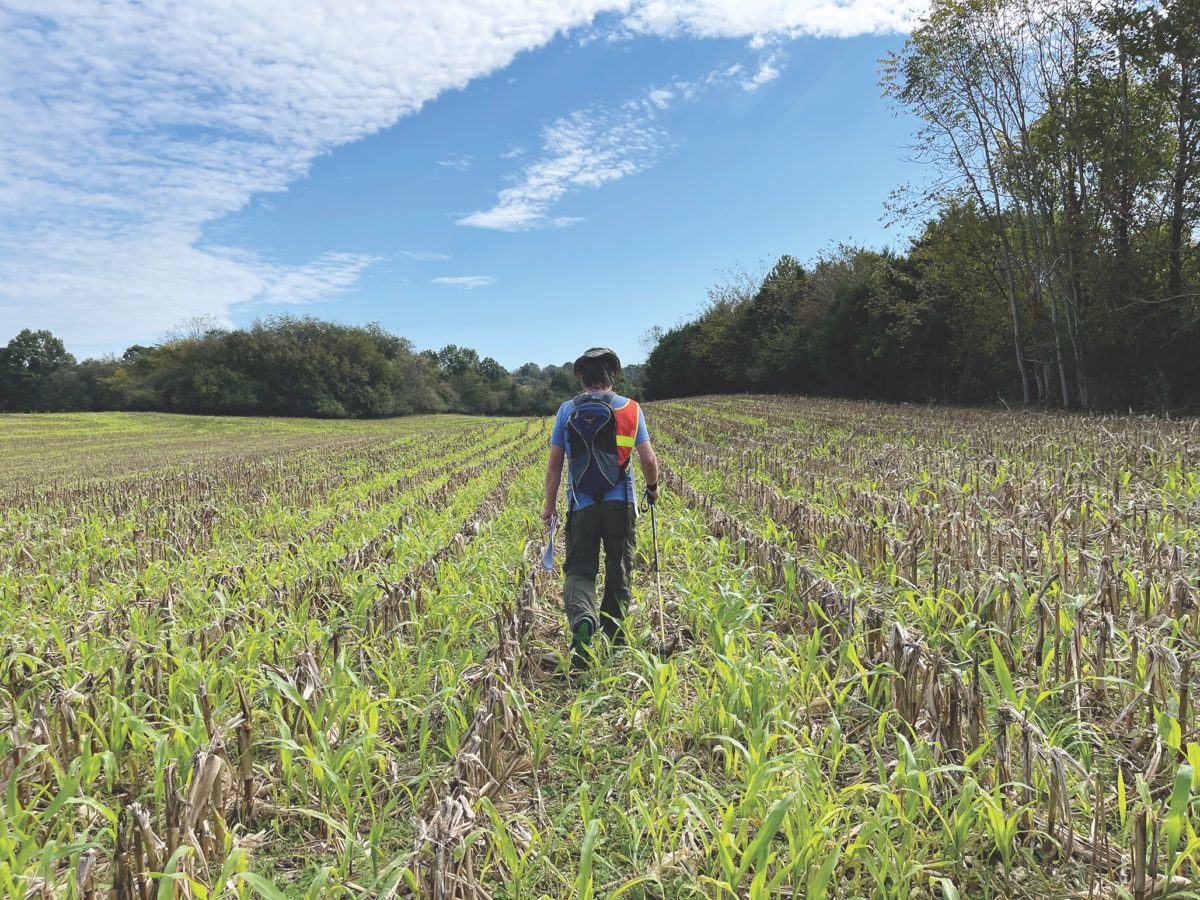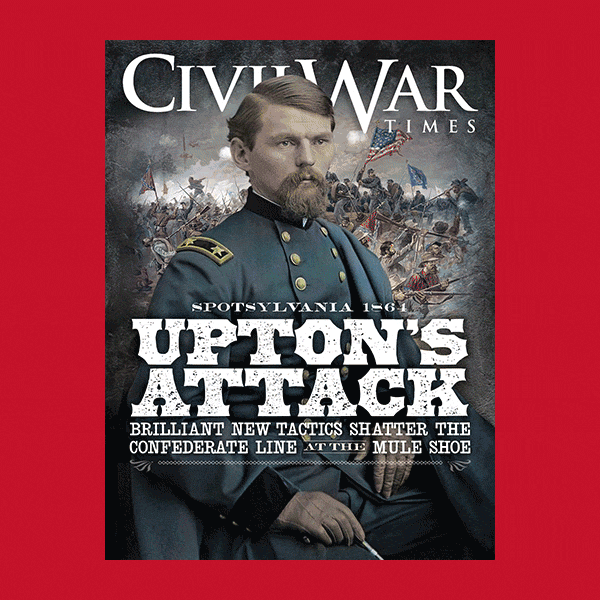Days before my visit to Davis Ford, a remote Duck River location near Columbia, Tenn., where 22,000 Confederates crossed in the late fall of 1864, guide Neal Pulley shoots me an eye-opening text: “Bring some orange. Don’t want to get shot! 😊”
No fan of becoming an inadvertent target of a deer hunter, I scour a big-box chain store for an orange vest. No luck in sporting goods. But in the men’s clothing section, another quarry is cornered: a gawd-awful, orange sweatshirt.
Poorer by $7.87, I toss my purchase into my duct-taped car and almost immediately suffer from buyer’s remorse. In a plastic box in the trunk rests a fluorescent, yellow cycling jacket—the perfect hiking attire.
This trip feels jinxed before it starts.
Still ornery, I drive the next morning to Columbia, Civil War country about 50 miles south of downtown Nashville, for a rendezvous with Pulley, an expert on obscure Davis Ford and the Battle of Columbia. Fabulous stories linger in the beautiful, rolling countryside a Confederate soldier called “God’s country.”
A couple miles from where Pulley and I meet south of town, Union officer-turned-Confederate cavalry commander Frank Armstrong married President James Polk’s great-niece on April 27, 1863. Confederate Maj. Gen. Earl Van Dorn, a notorious womanizer and married father of five, attended the nuptials at Rally Hill, a circa-1830s mansion that still stands. So did Brig. Gen. Nathan Bedford Forrest, the cavalry genius and infamous slave trader. Roughly a Napoleon cannon shot away stands the National Confederate Museum at Elm Springs, where the remains of the former Klansman were recently transferred from Memphis for reburial.
Months ago at the museum, I examined the bed Army of Tennessee commander John Bell Hood slept in while Union Maj. Gen. John Schofield’s Army of the Ohio marched past his soldiers in the dead of night in late November 1864—one of the war’s gutsiest moves. I’m no expert, but the one-legged, one-armed Hood probably didn’t curl up with the Confederate battle flag bedspread on that heirloom.
In the 1920s and ’30s, war relics were plentiful here in Maury County, where ground was trampled, camped on, and fought over by both armies. An acquaintance—a longtime relic hunter—enjoys telling stories of unearthing dozens of rare Whitworth bullets, Confederate belt plates, and thousands of other artifacts from area fields, woods, and construction sites. In the 1930s and ’40s, Pulley’s dad played with Civil War-era Enfield rifles in nearby Giles County, where he grew up. “They used to beat ’em on rocks,” Pulley says. Hunted squirrels with them, too.
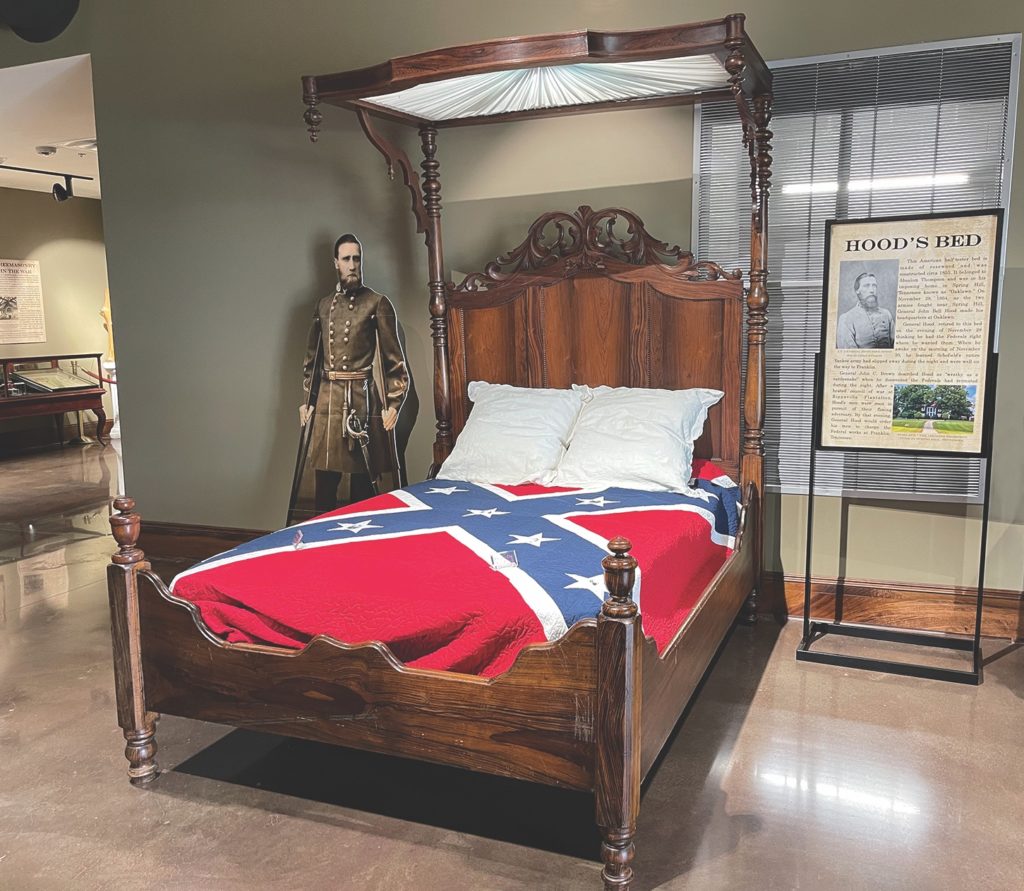
Before we depart for the ford, Pulley explains “The Burn Line,” homes torched by Yankees in 1864 to clear a field of fire. Then we ride down the highway in his pickup, turn off on a rutted route with bomb-like craters caused by storm washout, and park near an old road.
Nervous and achy (curses to you, arthritis!), I put on the fluorescent jacket while Pulley dons a vest of orange and yellow. Then he hands me a bottle of bug spray.
“What animals are out here?” I ask.
“Well, skunks. Bobcats, too.”
Damn, I hate cats.
And so we trudge up the road, about a mile from our destination.
A longtime student of the Civil War, Pulley spends spare time researching the Battle of Columbia—a series of skirmishes and sharp fights fought November 24-29, 1864—for a book he plans to write. The Columbia native has multiple connections to the war: One ancestor served under Hood in the 53rd Tennessee while another rode with Forrest. One fought in the U.S. Army, too—“a red leg, a traitor on my mother’s side,” he says, half-kidding. According to family lore, Pulley’s great-great-grandmother was inadvertently struck in the calf by a U.S. Army bullet while kneading dough in Giles County.
On farmland, in woodlots, and near fords of the Duck River at Columbia, the armies fought in a prelude to the brutal Battle of Franklin on November 30. Casualties were light—about 10 for the U.S. Army, roughly 25 for the Confederates. But no matter the size of the battle, some family member or sweetheart somewhere mourned when they received news of a loved one’s death.
Eliza Donley, whose son James was a 65th Illinois corporal, was one of them.
At Columbia on November 26, 1864, Donley’s leg was shattered between the foot and knee by an artillery shell. “He bore it bravely like a good soldier as he is,” 65th Illinois 1st Sgt. George Heywood wrote days later to Eliza. “We were driven from the field and out of 19 men in the company 7 were wounded & one killed. It left us so small that we could not bring them off.”
Shortly after his wounding, James died, probably in enemy hands as Schofield soldiers headed toward Nashville, their ultimate destination. “I asked them about your son & they told me that he was no more,” wrote Heywood in another letter to Eliza, nearly a month after her son’s death. “I was surprised and sorry to hear it.”
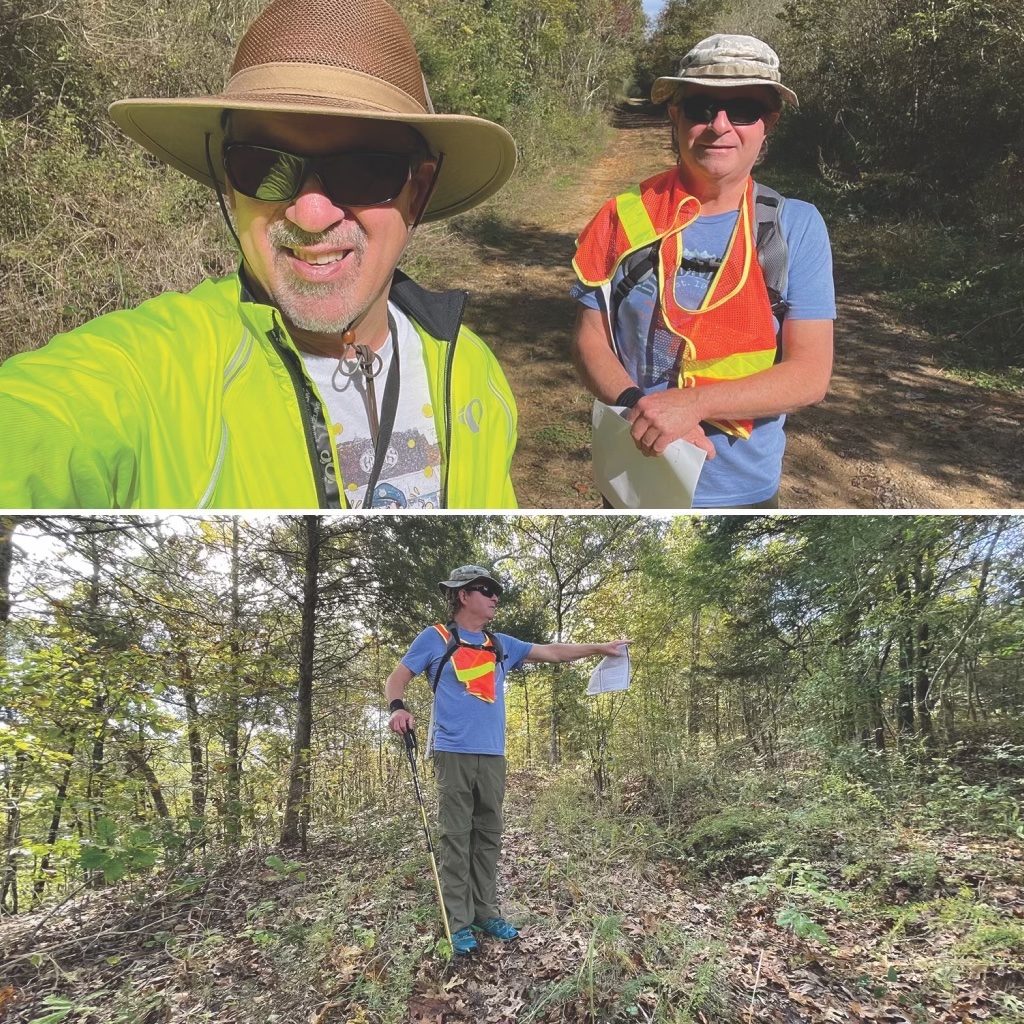
After Columbia, Hood aimed to flank Schofield’s army before it made it to Spring Hill. With a good chance to wreak havoc, he couldn’t dawdle. So, in late November 1864, he ordered a pontoon bridge built across the Duck River at Davis Ford.
To get to there, we navigate through a cornfield, deftly avoiding groundhog holes. “Careful,” Pulley says, “you can snap an ankle in those.” No worries. I’m expert at groundhog hole avoidance, having traipsed numerous times through David R. Miller’s Cornfield at Antietam.
We make our way to a rutted, military road on a bluff along the Duck River. The distant sounds of a plane overhead and a hunter’s gunshot do not ruin the greatness of the experience. Long before Hood’s soldiers, the ancient transportation route was used by 18th- and 19th-century pioneers as well as Creek Indians.
Then we take a circuitous route to the ford, trudging through briars and bushes, over fallen limbs and poison oak, and through muck and who-knows-what-else. “Any rattlesnakes here?” I ask. “Could be.” Pulley says. Wearing shorts and running shoes, hardly the best hiking attire, I soldier on. “Stupidity,” it’s commonly called.
If it weren’t for the three-inch snail darter, an endangered, freshwater ray-finned fish, Davis Ford may not even exist. In the early 1980s, the feds stopped construction of a $100 million, half-built dam in Tennessee when the endangered fish was discovered in the Duck River. “All this would have been underwater otherwise,” Pulley says after we finally arrive at the ford.
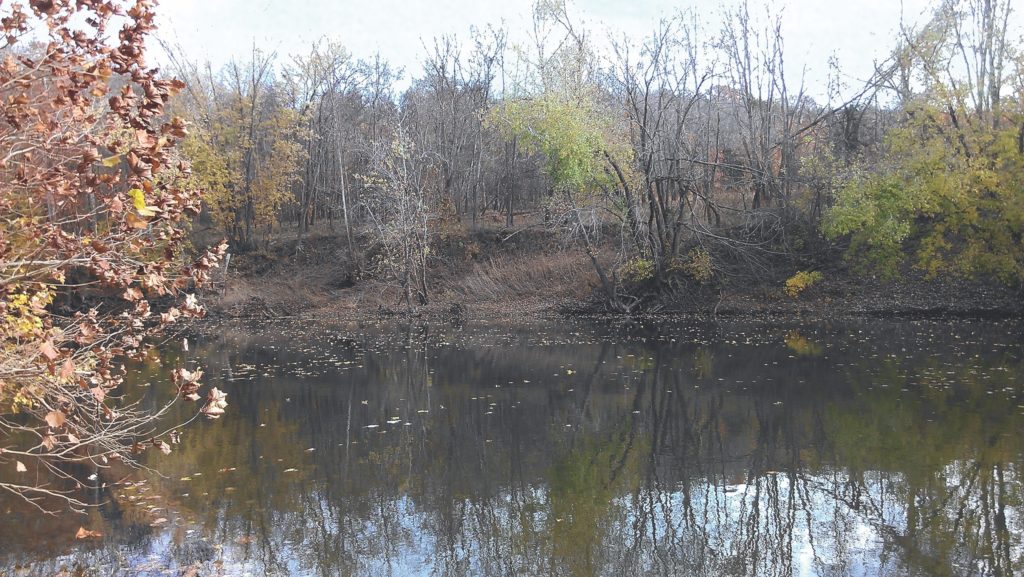
Through a maze of trees to our left, about 50 yards across the Duck River, rises the steep north bank. The water may be three or four feet deep. To the right stand huge mounds of deep-brown earth and remains of a cut in the south bank made by Hood’s engineers—unsung heroes of the war. Not another soul is in sight.
Imagine this scene the night of November 28, 1864, and the following morning:
One hundred sappers, miners, and diggers pitch in. Torches flicker as massive, wooden beams are pounded into the gravelly riverbed. By 1 a.m., trusses arrive to lay across the stringers—work that continues into the wee hours. Fifty soldiers dig a cut on the north bank, backbreaking labor done “all night without flinching,” the lieutenant in charge of the operation later recalls.
Near dawn, the trudging of thousands of feet rumble and rustle in the distance as the ragged, smelly Army of Tennessee marches on the narrow military road to the ford. Patrick Cleburne, Hood’s fiery, Irish-born division commander, chews out the officer in charge of the pontoon operation, peeved the south bank cut is incomplete. “He…abused me shamefully, and threatened to have me arrested and court-martialed for my failure,” remembers the lieutenant, “but I was never arrested.”
I wonder about the thousands of Confederates who crossed here shortly after dawn that frigid day long ago. Among them was Private Sam Watkins, a Columbia native who was pleased to be on home turf. “We have never forsaken our colors,” he wrote in his classic war memoir, Co. Aytch, about his return home. “Are we worthy to be called the sons of old Maury County?”
By nightfall on November 30 in Franklin, 30 miles north, hundreds of Watkins’ comrades who crossed Davis Ford would be dead. Mathew Andrew Dunn, a 30-year-old sergeant in the 33rd Mississippi, was one of them.
Four months before he was riddled with bullets at Franklin, Dunn prepared his wife, Virginia—he affectionately called her “Stumpy”—for awful possibilities. “Oh my love,” the father of two young children wrote, “if I could only See you and our dear little ones again what a pleasure it would be. But God only knows whether I will have that privilege or not. I want you to try and raise them up right. Train them while they are young.”
“And if I am not Spared to See you I hope we will meet in a happier world. . .
if I am killed I hope that I am prepared to go.”
Months later, a condolence letter arrived for “Stumpy” in Liberty, Miss.—population a few hundred.
“Dear Friend, though I join you in shedding a tear of grief, let us not mourn as those who are without hope,” wrote 33rd Mississippi Private John Wilkinson, “for we feel assured that our loss is his Eternal gain, that his freed spirit is now singing praises to our Blessed Savior in the Paradise above where all is joy and peace.”
Dunn’s remains probably rest in McGavock Confederate Cemetery in Franklin.
Perhaps his spirit, though, still hovers somewhere here near the banks of remote Davis Ford.
In 2015, John Banks waded the Potomac River from Maryland to West Virginia at Boteler’s Ford, an epic experience. You can read about it on his popular Civil War blog (john-banks.blogspot.com).

